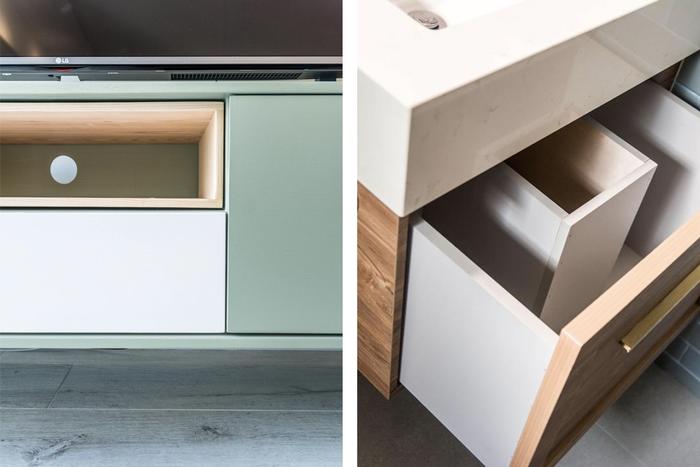What you should be aware of, according to an interior design firm that also specialises in bespoke woodwork.
Carpentry is an important part of any functional home – besides providing essential storage it also presents an opportunity to up your home’s look with the warm beauty of natural wood. But when it comes to the construction of custom wood built-ins and furniture, how can you know if you’re getting your money’s worth, especially if you’re just a layman who isn’t familiar with the trade?

To answer this question (and more!), we spoke to Lucas from Archive Design – who heads a small, but nimble interior design team that also offers custom carpentry and furniture services in Singapore.
1. What should homeowners look out for to ensure that they’re getting their money’s worth with custom carpentry?
Lucas (L): One way that homeowners can tell if the quality of their built-ins is good is by simply checking or asking their designer/carpenter about the materials used.
In Singapore, most of the time, carpentry built-ins are made from plywood because they’re an affordable and sturdy option. But that said, plywood comes in different grades which determine how well they’re able to stand up to wear-and-tear factors like heat and moisture.

View this project by Archive Design
For example, a bathroom vanity cabinet could be made from marine plywood, which is thicker and stronger due to it having more layers or sheets in between them. The glue used to stick these layers together is also waterproof, which ensures that they survive longer in humid environments.
You should also check to see if the joinery and other important mechanisms, like hinges and sliders, are working well. Quality ones from brands which we use, like Hafele and Blum, move smoothly and they don’t jiggle even when you open or close your cabinet doors/drawers.
2. What are some factors that contribute to the cost of custom carpentry?
L: Aside from the components and type of wood used, finishes and detailing are also some factors that’ll determine the cost of custom carpentry in your home.

View this project by Archive Design
To give them a clean look and feel, cabinets and drawers are sometimes finished with a laminate on the outside and a PVC layer on the inside. And depending on the quality and type of finishing material chosen, this can add to the final cost.
For instance, there are laminates that have special properties like enhanced scratch resistance or anti-fingerprint surfaces; and there are also PVC layers with unique colours or textures, which cost extra.

View this project by Archive Design
Detailing work, such as chevron or herringbone patterns, or additional components like mirrors and glass panels will contribute to the price of custom carpentry as well.
3. How long does it usually take to outfit an HDB flat with custom carpentry?
L: Let’s say we’re talking about a full HDB flat renovation where there are new built-ins added to the living room, kitchen and bathroom, it’ll usually take about 3 weeks to complete the process from fabrication to installation.

View this project by Archive Design
The fabrication process itself is actually quite short because it’ll take not more than 10 days to build the carcass (the body of a carpentry built-in) from the point that a client signs off the final design. After that, it takes a few more days for the carcass to be laminated and smoothened out with ABS trimming.

View this project by Archive Design
Installation only starts after the carcass and the components are delivered to the site; this step requires more time and coordination, especially in the kitchen, because it can only take place after any water/gas pipes and wires that run through the cabinetry are properly installed.
4. What are some key differences between getting customised carpentry and furniture?
L: The biggest difference is the type of wood used. We use three kinds for customised furniture, namely teak, sungkai and oak, which are all hard woods; they are very durable and dense, which means that they can stand up to humid weather and termites.

View this project by Archive Design
Teak is one of the best options for customised furniture due to its toughness and it’s highly suitable for local use because of its high oil content that keeps it from rotting. Oak, on the other hand, can be very easily dyed to achieve a favourite colour or tone that a customer may want.
5. What considerations should homeowners have in mind before getting custom furniture and/or carpentry for their homes?
L: Cost is definitely a consideration that they should have in mind, especially for customised furniture. Let’s say, we’re talking about a 3-seater sofa – just the hardwood structure alone without any cushions – it’ll cost between $1000 to $2000, depending on how intricate the requested design is.

View this project by Archive Design
You might also wish to consider how long you’ll be using your customised built-ins and furniture. If you’re shifting into a BTO flat and thinking about moving out 5 years later to another home with totally new built-ins or have plans to leave your customised hardwood furniture behind, it might be prudent for you not to invest too much.
But on the other hand, if you’re staying for long, spending on these items will be worth your money because they’ll add to your home’s functionality and also make it look the way you want.
Looking for professional renovation help?
Whether it's customised carpentry work or a total interior revamp that you need, our renovation professionals have the right solutions. Simply let us know your renovation requirements and get quick, personalised renovation quotes from five local interior design firms for free!
Also, when you engage an interior firm through our free recommendation service, you'll be eligible for the Qanvast Guarantee – a free scheme that safeguards up to $50,000 of your renovation deposits.

 Get a budget estimate before meeting IDs
Get a budget estimate before meeting IDs